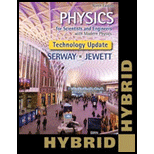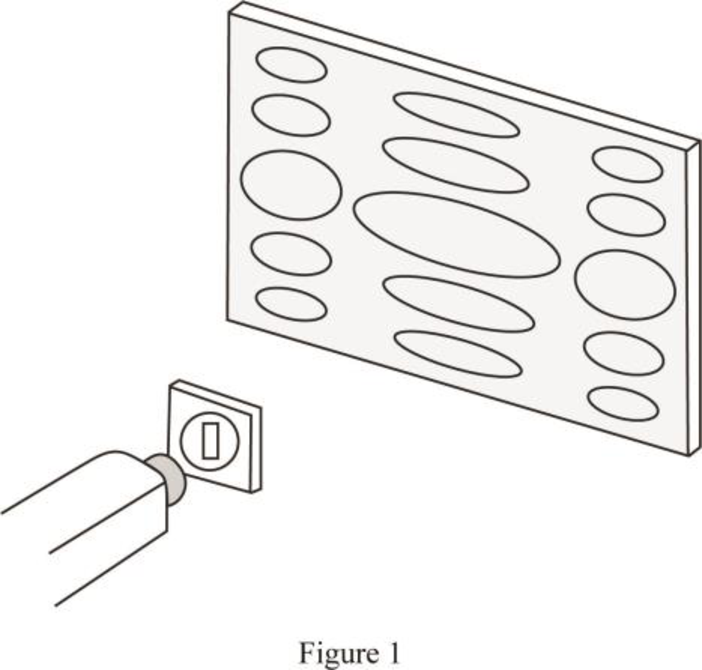
Concept explainers
(a)
The width of aperture.
(a)
Answer to Problem 4P
The width of aperture is
Explanation of Solution
On looking at the figure P38.4, width of the rectangular patch is more than that of its height.
Write the equation for tangent of angular width of aperture.
Here,
Since
Write the relation between width of aperture and the wavelength of light used for first order diffraction pattern.
Here,
Conclusion:
Substitute
Substitute
Rewrite the above expression in terms of
Therefore, the width of aperture is
(b)
The height of aperture.
(b)
Answer to Problem 4P
The height of aperture is
Explanation of Solution
On looking at the figure P38.4, width of the rectangular patch is more than that of its height.
Write the equation for tangent of angular width of aperture.
Here,
Since
Write the relation between width of aperture and the wavelength of light used for first order diffraction pattern.
Here,
Conclusion:
Substitute
Substitute
Rewrite the above expression in terms of
Therefore, the height of aperture is
(c)
Check whether the horizontal or vertical dimension of central bright portion is greater.
(c)
Answer to Problem 4P
Horizontal dimension of central bright portion is longer than its vertical dimension.
Explanation of Solution
Draw the diagram showing the diffraction pattern on light passing through a circular aperture.

From the diagram, it can be seen that the central bright patch has an ellipse shape. It has greater length in horizontal direction than in vertical direction.
Therefore, the horizontal dimension of central bright portion is longer than its vertical dimension.
(d)
Check whether the horizontal or vertical dimension of aperture is greater.
(d)
Answer to Problem 4P
Vertical dimension of aperture is greater.
Explanation of Solution
Refer the diagram shown in part (c). From the diagram, it is understood that to obtain diffraction pattern with greater horizontal dimension its vertical length, the vertical length of aperture must be greater than that of horizontal length. If the horizontal dimension of aperture is greater, the vertical dimension of bright becomes greater than that of the horizontal dimension.
Therefore, the vertical dimension of aperture is greater.
(e)
Identify the relation between the two rectangles given in question with the help of a diagram.
(e)
Answer to Problem 4P
The distances between edges of rectangular aperture is inversely proportional to size of central maxima rectangle on the wall.
Explanation of Solution
Refer the figure 1shown in part (c). The size of aperture is inversely proportional to the size of diffraction pattern. Smaller the size of aperture, larger will be the size of diffraction pattern. It is found that the width of aperture is
Therefore, the distances between edges of rectangular aperture is inversely proportional to size of central maxima rectangle on the wall.
Want to see more full solutions like this?
Chapter 38 Solutions
Physics for Scientists and Engineers with Modern, Revised Hybrid (with Enhanced WebAssign Printed Access Card for Physics, Multi-Term Courses)
- A horizontal laser beam of wavelength 632.8 nm has a circular cross section 2.00 nun in diameter. A rectangular aperture is to lie placed in the center of the beam so that when the light falls perpendicularly on a wall 4.50 m away, the central maximum fills a rectangle 110 mm wide and 6.00 mm high. The dimensions are measured between the minima bracketing the central maximum. Find the required (a) width and (b) height of the aperture. (c) Is the longer dimension of the central bright patch in the diffraction pattern horizontal or vertical? (d) Is the longer dimension of the aperture horizontal or vertical? (e) Explain the relationship between these two rectangles, using a diagram.arrow_forwardA beam of 580-nm light passes through two closely spaced glass plates at close to normal incidence as shown in Figure P27.23. For what minimum nonzero value of the plate separation d is the transmitted light bright?arrow_forwardThe structure of the NaCl crystal forms reflecting planes 0.541 nm apart. What is the smallest angle, measured from these planes, at which X-ray diffraction can be observed, if X-rays of wavelength 0.085 nm are used?arrow_forward
- let a beam of x rays of wavelength 0.125 nm be incident on an NaCl crystal at angle u 45.0° to the top face of the crystal and a family of reflecting planes. Let the reflecting planes have separation d = 0.252 nm. The crystal is turned through angle f around an axis perpendicular to the plane of the page until these reflecting planes give diffraction maxima. What are the (a) smaller and (b) larger value of f if the crystal is turned clockwise and the (c) smaller and (d) larger value of f if it is turned counterclockwise?arrow_forwardOften in optics scientists take advantage of effects that require very high intensity light. To get the desired effect a scientist uses a laser with power P = 0.0015 W to reach an intensity of I = 350 W/cm2 by focusing it through a lens of focal length f = 0.15 m. The beam has a radius of r = 0.0011 m when it enters the lens.Randomized VariablesP = 0.0015 WI = 350 W/cm2f = 0.15 mr = 0.0011 m Part (a) Express the radius of the beam, rp, at the point where it reaches the desired intensity in terms of the given quantities. (In other words, what radius does the beam have to have after passing through the lens in order to have the desired intensity?) Part (b) Give an expression for the tangent of the angle that the edge of the beam exits the lens with with respect to the normal to the lens surface, in terms of r and f? Part (c) Express the distance, D, between the lens's focal point and the illuminated object using tan(α) and rp. Part (d) Find the distance, D, in centimeters.arrow_forwardA telescope can be used to enlarge the diameter of a laser beam and limit diffraction spreading. The laser beam is sent through the telescope in opposite the normal direction and can then be projected onto a satellite or the Moon. (a) If this is done with the Mount Wilson telescope, producing a 2.54-m-diameter beam of 633-nm light, what is the minimum angular spread of the beam? (b) Neglecting atmospheric effects, what is the size of the spot this beam would make on the Moon, assuming a lunar distance of 3.84×108 m ?arrow_forward
- . The velocity of light in the core of a step index fiber is 2.01 × 108 m s-1, and the critical angle at the core-cladding interface is 80°. Determine the numerical aperture and the acceptance angle for the fiber in air, assuming it has a core diameter suitable for consideration by ray analysis. The velocity of light in a vacuum is 2.998 x 103 m s-1arrow_forwardAn optical coherence tomography (OCT) system for imaging the retina in the human eye uses a superluminescent diode (SLD) emitting a spectrum centred at 850 nm with a Gaussian shape of full width half maximum of 50 nm. The scanning beam entering the eye has a beam diameter of 3 mm and the retina tissue exhibits an index of refraction of n = 1.39. The equivalent eye length is 2.3 cm. Given the numerical values listed above, estimate: (a) the axial resolution, (b) and the lateral resolution of the system in producing cross section OCT images of the retina.arrow_forwardA laser beam with wavelength λ = 550 nm hits a grating with n = 2250 grooves per centimeter. Part (b) Find the sin of the angle, θ2, at which the 2nd order maximum will be observed, in terms of d and λ. sin(θ2) =arrow_forward
- Parameters of a Dielectric Waveguide. Light of free-space wavelength X, = 0.87 um is guided by a thin planar film of width d = 2 μm and refractive index n₁ = 1.6 surrounded by a medium of refractive index n₂ = 1.4. (a) Determine the critical angle 0, and its complement c, the numerical aperture NA, and the maximum acceptance angle for light originating in air (n = 1). (b) Determine the number of TE modes. (c) Determine the bounce angle and the group velocity v of the m= 0 TE mode.arrow_forwardA He-Ne gas laser which produces monochromatic light of a known wavelength ? =6.35 ? 10^7 ? is used to calibrate a reflection grating in a spectroscope. The first-order diffraction line is found at an angle of 22 degrees to the incident beam. How many lines per meter are there on the grating?arrow_forwardOptical fibers are constructed with a cylindrical core surrounded by a sheath of cladding material. Common materials used are pure silica (n2 = 1.450) for the cladding and silica doped with germanium (n1 = 1.465) for the core. (a) What is the critical angle θcrit for light traveling in the core and reflecting at the interface with the cladding material? (b) The numerical aperture (NA) is defined as the angle of incidence θi at the flat end of the cable for which light is incident on the core–cladding interface at angle θcrit. Show that sin θi = √(n21 - n22) . (c) What is the value of θi for n1 = 1.465 and n2 = 1.450?arrow_forward
 Principles of Physics: A Calculus-Based TextPhysicsISBN:9781133104261Author:Raymond A. Serway, John W. JewettPublisher:Cengage Learning
Principles of Physics: A Calculus-Based TextPhysicsISBN:9781133104261Author:Raymond A. Serway, John W. JewettPublisher:Cengage Learning Physics for Scientists and Engineers, Technology ...PhysicsISBN:9781305116399Author:Raymond A. Serway, John W. JewettPublisher:Cengage Learning
Physics for Scientists and Engineers, Technology ...PhysicsISBN:9781305116399Author:Raymond A. Serway, John W. JewettPublisher:Cengage Learning University Physics Volume 3PhysicsISBN:9781938168185Author:William Moebs, Jeff SannyPublisher:OpenStax
University Physics Volume 3PhysicsISBN:9781938168185Author:William Moebs, Jeff SannyPublisher:OpenStax


